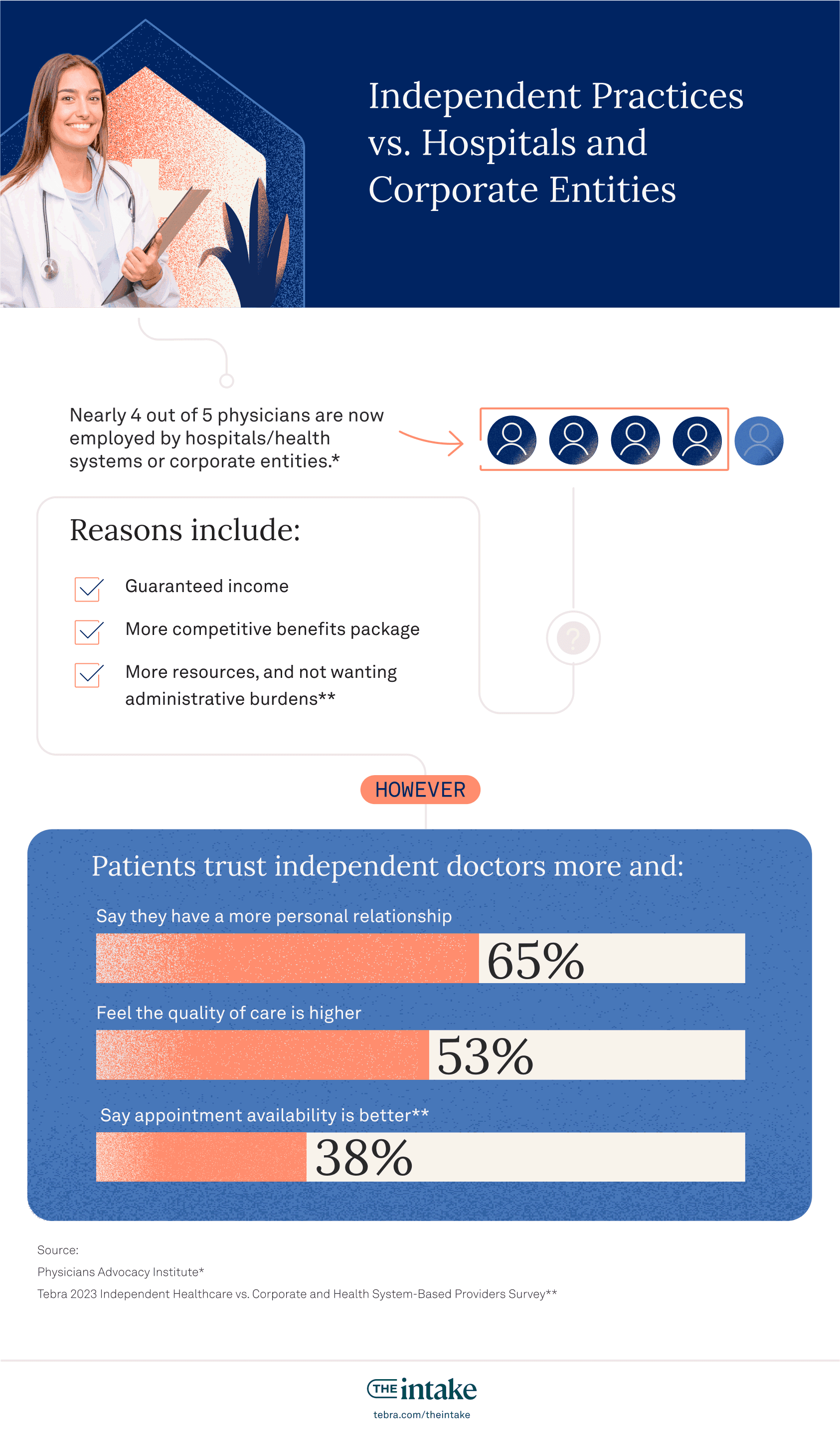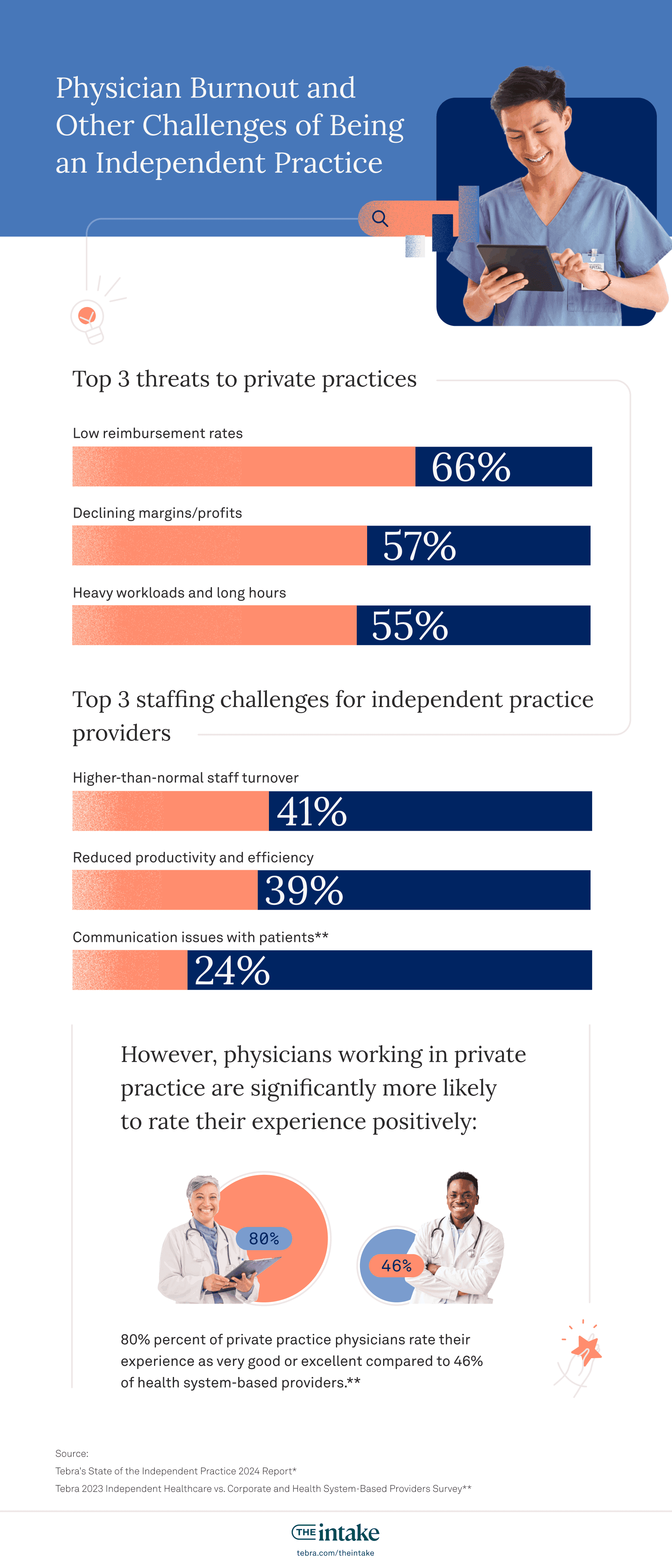40+ interesting facts about doctors and independent practices to celebrate National Doctors Day
We’re wishing a happy National Doctors Day to providers by sharing over 40 interesting stats on doctors and independent practices.

Overview
- Doctors complete years of training, averaging 10-14 years post-secondary.
- Primary care physicians have the highest patient interaction rates.
- Advancements in telehealth and AI are shaping the future of medicine.
Behind every life saved and moment of compassionate care are dedicated doctors who work tirelessly to heal and protect our communities. March 30 is National Doctors Day, a moment to recognize the extraordinary individuals who transform scientific knowledge into human resilience — often sacrificing their own well-being to ensure the health of others..
Read on to learn about this holiday, along with over 40 fascinating facts about doctors and independent practices.
Download your free resource now
Access it instantly — just complete the form

What is National Doctors Day?
National Doctors Day is a day to celebrate and recognize medical doctors and their contributions to society. The United States Congress designated the holiday on March 30, 1991, with the passing of Public Law 101- 473. In addition, Former US President George Bush issued a proclamation in observance of the day on February 21, 1991.
In 2025, National Doctors Day will be celebrated on Sunday, March 30.
“National Doctors Day is a day to celebrate and recognize medical doctors and their contributions to society.”
History of National Doctors Day
On this date in 1842, Dr. Crawford Williamson Long performed the first surgery with anesthesia. He painlessly removed a tumor from a patient by first administering ether. There is some controversy about which doctor discovered anesthesia. However, Dr. Long is widely accepted today as the pioneer of surgical anesthesia through inhalation of ether.
Nearly 30 years later, in 1933, Eudora Brown Almond, a Georgia woman married to a physician, decided that medical doctors deserved a designated day to acknowledge their unique contributions to society. She selected March 30 in homage to Dr. Long.
Per “How March 30th Came to be Doctors’ Day,” by Rod K. Calverley: “From the time of her early childhood in rural Ft. Lamar, GA, Eudora Brown had admired the gentle kindness of her family doctor. In 1920, Eudora married Dr. Charles B. Almond and, believing that healing the sick was man’s greatest profession, became convinced that medical practitioners deserved a day of recognition. She selected March 30 to honor the man she considered Georgia’s most famous son.”
Do doctors celebrate National Doctors Day?
You may see medical doctors sporting red carnations, the symbolic flower of National Doctors Day, on March 30. Other medical providers might also mark the day by distributing commemorative cards, as Eudora Brown Almond did in 1933. They may commemorate the day with small Doctors Day gifts such as lapel pins.
“You may see medical doctors sporting red carnations on March 30.”
On her blog ParagonFire, Kelly Cawcutt, MD, MS, wrote, “I am not sure that we celebrate it in the way Hallmark would suggest. I think we celebrate it not for ourselves, but in deep, sometimes wordless, appreciation of our colleagues. In recognition of the commitment and care of our colleagues.” She continued, “And at the end of the day, we do not toast ourselves. We toast our colleagues and silently strive to improve. To be worthy of the thank you, the note of appreciation, the calling.”
| Grow your practice — not your workload — with Tebra's innovative marketing solutions built for independent providers. |
What is it like to be a doctor today?
The Intake’s Independent Healthcare Practice Ownership report revealed much about the state of private practice today. With data from 112 physicians, we learned that while most physicians are optimistic about their own practice, they have serious concerns about the industry as a whole.
“The healthcare industry is plagued by dissatisfaction — both from providers and patients,” says Lauren Wheeler, a former family medicine physician currently working as a healthcare advocate and medical editor. Wheeler said that long working hours, physician reimbursements, and competition from private equity-backed healthcare systems coalesce to create growing discontentment.
But this is just a glimpse of the full picture. See the Doctors Day 2025 facts and infographics below for 40 interesting facts about doctors today.
National Doctors Day facts at a glance
- On March 30, 1842, Dr. Crawford Williamson Long pioneered surgical anesthesia through inhalation of ether.
- On March 30, 1933, Eudora Brown Almond — a Georgia woman married to a physician — decided that medical doctors deserved a designated day to acknowledge their unique contributions to society. She selected March 30 in homage to Dr. Long.
- Former US President George Bush issued a proclamation in observance of the day on February 21, 1991.
- The US Congress designated the holiday on March 30, 1991, with the passing of Public Law 101- 473.
- Nearly 4 out of 5 physicians are now employed by hospitals/health systems or corporate entities.
- Reasons physicians choose to work for hospitals/health systems or corporate entities are guaranteed income, competitive benefits packages, more resources, and not wanting administrative burdens.
- 65% of patients say they have a more personal relationship with independent doctors.
- 51% of patients feel the quality of care is higher with independent doctors.
- 52% of patients say appointment availability is better with independent doctors.
- The majority of independent practice owners have concerns about the industry, and say their business model is extremely, very, or somewhat threatened.
- 58% of independent providers plan to add new providers in 2025.
- 60% of independent providers plan to provide new services in 2025.
- 62% of independent providers plan to increase profitability in 2025.
- 63% of independent providers plan to establish new offices or locations in 2025.
- 64% of independent providers plan to increase revenue in 2025.
- Employment growth for physicians and surgeons is projected to grow 4% from 2023 to 2033, about as fast as all professions.
- There are 535,012 primary care physicians in the US.
- There are 566,723 specialist physicians in the US.
- There are 1,109,460 professionally active physicians total in the US.
- California has the most physicians in the US.
- New York has the 2nd highest amount of physicians in the US.
- Texas has the 3rd highest number of physicians in the US.
- In 2023, 49.7% of physicians were employees.
- In 2023, 44% of physicians were owners.
- In 2023, 6.4% of physicians were independent contractors.
- The average salary for primary care physicians is $313,200.
- From 2012 to 2022 the share of physicians who work in private practices dropped from 60.1% to 46.7%.
- Many practice owners anticipate growth in 2025, with 64% anticipating increased revenue.
- The average independent practice sees 1,896 patients per month.
- To improve practice health, 82% of independent providers would like to see improved reimbursement rates.
- 60% of independent providers would like to see decreased overhead.
- 54% of independent providers want reduced administrative burden.
- 37% of independent providers want greater flexibility in payment models.
- 66% of private practices feel threatened by low reimbursement rates.
- 57% of private practice feel threatened by declining margins/profits.
- 55% of private practices feel threatened by heavy workloads and long hours.
- 41% of of independent practices experience higher-than-normal staff turnover.
- 39% of independent providers experience reduced productivity and efficiency.
- 24% of independent providers experience communication issues with patients.
- 80% of private practice physicians rate their experience as very good or excellent.
- 46% of health system-based providers rate their experience as very good or excellent.
| Keep your patients coming back with Tebra's advanced patient experience software. |
Independent practices vs. hospitals and corporate entities
Each year, an increasing number of physicians leave independent practice for the financial stability health systems offer. However, Tebra's 2023 Independent Healthcare vs. Corporate and Health System-Based Providers Survey found that — unlike larger corporate or public health systems — independent practices prioritize personalized care. Independent providers spend more time with individual patients in order to truly understand their needs.

Independent practice providers in the field
The share of physicians who work in private practices dropped from 60.1% to 46.7% from 2012 to 2022, according to the 2022 Physician Practice Benchmark Survey. Tebra research found that the majority of independent providers have concerns about their industry. They also feel their business model is threatened.

However, the optimism practice owners have around growth remains strong:
- 64% anticipate increased revenue
- 63% intend to establish new offices or locations
- 62% expect to grow profitability
- 60% anticipate adding new services
- 58% plan to add new providers

An independent practice and provider's average month
Tebra research found that, despite pessimistic views of the industry, a majority of practice owners expect to remain independent over the next 5 to 10 years. A total of 33% find it completely likely, 39% find it very likely, and 19% find it somewhat likely. Only 9% say it's unlikely, with 8% selecting hardly likely and 1% selecting not at all likely.
What changes do independent providers want to see to remain independent?
- Reduced administrative burden (54%)
- Improved reimbursement rates (82%)
- Decreased overhead (60%)
- Standardized coding for medical billing (29%)
- Technology designed for independent practices (29%)
- Greater flexibility in payment models (37%)
- More influence in regulations and/or government advocacy (21%)
- More education around the business of practice in medical school and/or training programs (25%)
- Better access to staffing and recruiting pipeline (29%)
- Improved support for mental health (24%)

Physician burnout and other challenges of being an independent practice
Tebra research revealed that independent providers are experiencing less burnout than health-system providers. In fact, 15% of independent providers Tebra surveyed said they are not at all burned out. On the other hand, 100% of health-system-based providers reported varying degrees of burnout.
However, independent providers still feel top threats to their practices:
- Low reimbursement rates (54%)
- Declining margins/profits (57%)
- Heavy workloads and long hours (55%)
Staffing shortages tie with heavy workloads and long hours as the top challenge. When it comes to staffing challenges overall, independent providers also reported:
- Higher-than-normal staff turnover (41%)
- Reduced productivity and efficiency (39%)
- Communication issues with patients (24%)
However, physicians working in private practice are significantly more likely to rate their experience positively. Tebra's research shows that 80% rate their experience as very good or excellent. This is higher than 46% of health system-based providers who say the same.

Looking ahead
As we look ahead, the future of healthcare seems to be at a crossroads. Independent practices are striving to maintain their autonomy while navigating the complexities of modern healthcare.
The optimism among practice owners, coupled with their commitment to personalized care, suggests a hopeful outlook. They remain positive despite the challenges of administrative burdens, competition, and physician burnout.
National Doctors Day serves as a reminder of the pivotal role doctors play in our lives, often under challenging circumstances. The resilience and dedication of medical professionals underscore the critical need for support and recognition from the wider community and healthcare industry.
| Experience Tebra's suite of digital tools and support built to help your independent practice attract new patients, deliver modern care, get paid quickly, and operate efficiently. |
Download your free resource now
Access it instantly — just complete the form

You might also be interested in
Optimize your independent practice for growth. Get actionable strategies to create a superior patient experience, retain patients, and support your staff while growing your medical practice sustainably and profitably.
- Current Version – Mar 28, 2025Written by: Catherine TanseyChanges: This article was updated to include the most relevant and up-to-date information available.





